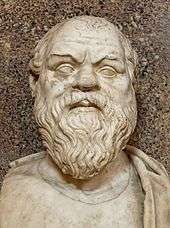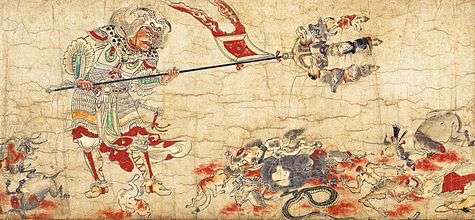Good
In most contexts, the concept of good denotes the conduct that should be preferred when posed with a choice between possible actions. Good is generally considered to be the opposite of evil, and is of interest in the study of morality, ethics, religion and philosophy. The specific meaning and etymology of the term and its associated translations among ancient and contemporary languages show substantial variation in its inflection and meaning depending on circumstances of place, history, religious, or philosophical context.

History of ideas
Every language has a word expressing good in the sense of "having the right or desirable quality" (ἀρετή) and bad in the sense "undesirable". A sense of moral judgement and a distinction "right and wrong, good and bad" are cultural universals.[1]
Plato and Aristotle

Although the history of the origin of the use of the concept and meaning of 'good' are diverse, the notable discussions of Plato and Aristotle on this subject have been of significant historical effect. The first references that are seen in Plato's The Republic to the Form of the Good are within the conversation between Glaucon and Socrates (454c–d). When trying to answer such difficult questions pertaining to the definition of justice, Plato identifies that we should not “introduce every form of difference and sameness in nature” instead we must focus on "the one form of sameness and difference that was relevant to the particular ways of life themselves” which is the form of the Good. This form is the basis for understanding all other forms, it is what allows us to understand everything else. Through the conversation between Socrates and Glaucon (508a–c) Plato analogizes the form of the Good with the sun as it is what allows us to see things. Here, Plato describes how the sun allows for sight. But he makes a very important distinction, “sun is not sight” but it is “the cause of sight itself.” As the sun is in the visible realm, the form of Good is in the intelligible realm. It is “what gives truth to the things known and the power to know to the knower”. It is not only the “cause of knowledge and truth, it is also an object of knowledge”.
Plato identifies how the form of the Good allows for the cognizance to understand such difficult concepts as justice. He identifies knowledge and truth as important, but through Socrates (508d–e) says, “good is yet more prized”. He then proceeds to explain “although the good is not being” it is “superior to it in rank and power”, it is what “provides for knowledge and truth” (508e).[2]
In contrast to Plato, Aristotle discusses the Forms of Good in critical terms several times in both of his major surviving ethical works, the Eudemian and Nicomachean Ethics. Aristotle argues that Plato's Form of the Good does not apply to the physical world, for Plato does not assign “goodness” to anything in the existing world. Because Plato's Form of the Good does not explain events in the physical world, humans have no reason to believe that the Form of the Good exists and the Form of the Good is thereby irrelevant to human ethics.[3]
Plato and Aristotle were not the first contributors in ancient Greece to the study of the 'good' and discussion preceding them can be found among the pre-Socratic philosophers. In Western civilisation, the basic meanings of κακός and ἀγαθός are "bad, cowardly" and "good, brave, capable", and their absolute sense emerges only around 400 BC, with Pre-Socratic philosophy, in particular Democritus.[4] Morality in this absolute sense solidifies in the dialogues of Plato, together with the emergence of monotheistic thought (notably in Euthyphro, which ponders the concept of piety (τὸ ὅσιον) as a moral absolute). The idea is further developed in Late Antiquity by Neoplatonists, Gnostics, and Church Fathers.
Ancient religions

Aside from ancient Greek studies of the 'good', the eastern part of ancient Persia almost five thousand years ago a religious philosopher called Zoroaster simplified the pantheon of early Iranian gods[5] into two opposing forces: Ahura Mazda (Illuminating Wisdom) and Angra Mainyu (Destructive Spirit) which were in conflict.
For the western world, this idea developed into a religion which spawned many sects, some of which embraced an extreme dualistic belief that the material world should be shunned and the spiritual world should be embraced. Gnostic ideas influenced many ancient religions[6] which teach that gnosis (variously interpreted as enlightenment, salvation, emancipation or 'oneness with God') may be reached by practising philanthropy to the point of personal poverty, sexual abstinence (as far as possible for hearers, total for initiates) and diligently searching for wisdom by helping others.[7]
This development from the relative or habitual to the absolute is also evident in the terms ethics and morality both being derived from terms for "regional custom", Greek ἦθος and Latin mores, respectively (see also siðr).
Medieval period
_-_stained_glass%2C_St._Thomas_Aquinas%2C_detail.jpg)
Medieval Christian philosophy was founded on the work of the Bishop Augustine of Hippo and theologian Thomas Aquinas who understood evil in terms of Biblical infallibility and Biblical inerrancy, as well as the influences of Plato and Aristotle in their appreciation of the concept of the Summum bonum. Silent contemplation was the route to appreciation of the Idea of the Good.[8]
Many medieval Christian theologians both broadened and narrowed the basic concept of Good and evil until it came to have several, sometimes complex definitions[9] such as:
- a personal preference or subjective judgment regarding any issue which might be earn praise or punishment from the religious authorities
- religious obligation arising from Divine law leading to sainthood or damnation.
- a generally accepted cultural standard of behaviour which might enhance group survival or wealth
- natural law or behaviour which induces strong emotional reaction
- statute law imposing a legal duty
Modernity
Kant
A significant enlightenment context for studying the 'good' has been its significance in the study of "the good, the true and the beautiful" as found in Immanuel Kant and other Enlightenment philosophers and religious thinkers. These discussion were undertaken by Kant particularly in the context of his Critique of Practical Reason.
Rawls
John Rawls' book A Theory of Justice prioritized social arrangements and goods based on their contribution to justice. Rawls defined justice as fairness, especially in distributing social goods, defined fairness in terms of procedures, and attempted to prove that just institutions and lives are good, if rational individuals' goods are considered fairly. Rawls's crucial invention was the original position, a procedure in which one tries to make objective moral decisions by refusing to let personal facts about oneself enter one's moral calculations.
Opposition to evil

In religion, ethics, and philosophy, "good and evil" is a very common dichotomy. In cultures with Manichaean and Abrahamic religious influence, evil is usually perceived as the antagonistic opposite of good. Good is that which should prevail and evil should be defeated.[10] In cultures with Buddhist spiritual influence, this antagonistic duality itself must be overcome through achieving Śūnyatā, or emptiness. This is the recognition of good and evil not being unrelated, but two parts of a greater whole; unity, oneness, a Monism.[10]
As a religious concept, basic ideas of a dichotomy between good and evil has developed so that today:
- Good is a broad concept but it typically deals with an association with life, charity, continuity, happiness, love and justice.
- Evil is typically associated with conscious and deliberate wrongdoing, discrimination designed to harm others, humiliation of people designed to diminish their psychological needs and dignity, destructiveness, and acts of unnecessary and/or indiscriminate violence.[11]
- the dilemma of the human condition and humans' and their capacity to perform both good and evil activities.[12]
Biology
Morality is regarded by some biologists (notably Edward O. Wilson, Jeremy Griffith, David Sloan Wilson and Frans de Waal) as an important question to be addressed by the field of biology.[13][14][15][16]
See also
|
|
|
References
- Donald Brown (1991) Human Universals. Philadelphia, Temple University Press (online summary).
- Plato (1992). Republic. Translated by C.D.C. Reeve (2nd ed.). Indianapolis, Ind.: Hackett Publ. Co. ISBN 978-0-87220-136-1.
- Fine, Gail (2003). Plato on Knowledge and Forms. New York: Oxford University Press. pp. 350. ISBN 0-19-924559-2.
- Charles H. Kahn, Democritus and the Origins of Moral Psychology, The American Journal of Philology (1985)
- Boyce 1979, pp. 6–12.
- John Hinnel (1997). The Penguin Dictionary of Religion. Penguin Books UK.
- Churton, Tobias (2005). Gnostic Philosophy: From Ancient Persia to Modern Times. Inner Traditions – Bear & Company. ISBN 978-159477-035-7.
- A. Kojeve, Introduction to the Reading of Hegel (1980) p. 108
- Farley, E (1990). Good and Evil: Interpreting a Human Condition. Fortress Press / Vanderbilt University. ISBN 978-0800624477.
- Paul O. Ingram, Frederick John Streng. Buddhist-Christian Dialogue: Mutual Renewal and Transformation. University of Hawaii Press, 1986. P. 148-149.
- Ervin Staub. Overcoming evil: genocide, violent conflict, and terrorism. New York, New York, USA: Oxford University Press, Pp. 32.
- Griffith, Jeremy (2011). "The Human Condition". The Book of Real Answers to Everything!. ISBN 9781741290073.
- Wilson, Edward Osborne (2012). The Social Conquest of Earth. ISBN 9780871404138.
- Griffith, Jeremy (2011). Good vs Evil. The Book of Real Answers to Everything!. ISBN 9781741290073.
- Wilson, Edward Osborne (2007). Evolution for Everyone: How Darwin's Theory Can Change the Way We Think About Our Lives. ISBN 9780385340922.
- de Waal, Frans (2012). Moral behavior in animals.
Further reading
- Aristotle. "Nicomachean Ethics". 1998. USA: Oxford University Press. (1177a15)
- Bentham, Jeremy. The Principles of Morals and Legislation. 1988. Prometheus Books.
- Boyce, Mary. Zoroastrians: Their Religious Beliefs and Practices, London: Routledge/Kegan Paul 1979; Corrected repr. 1984; repr. with new foreword 2001.
- Dewey, John. Theory of Valuation. 1948. University of Chicago Press.
- Griffin, James. Well-Being: Its Meaning, Measurement and Moral Importance. 1986. Oxford: Oxford University Press.
- Hume, David. A Treatise of Human Nature. 2000. Oxford: Oxford University Press.
- Hurka, Thomas. Perfectionism. 1993. Oxford: Oxford University Press.
- Kant, Immanuel. Groundwork of the Metaphysic of Morals. 1996. Cambridge University Press. Third section, [446]-[447].
- Kierkegaard, Søren. Either/Or. 1992. Penguin Classics.
- Rawls, John. A Theory of Justice. 1999. Belknap Press.
- Ross, W. D. The Right and the Good. 1930. Oxford University Press.